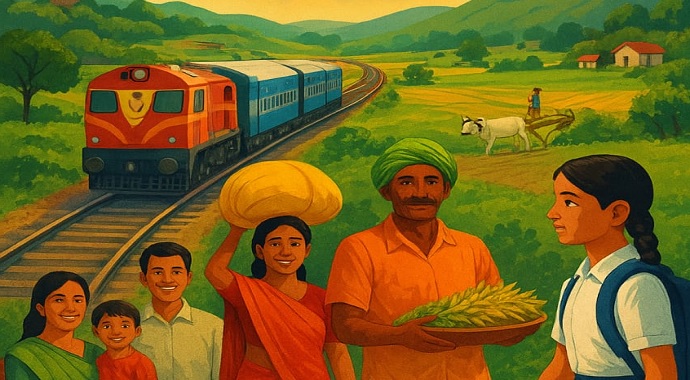Tracks of Change: How India’s New Railway Projects Will Transform Lives
For generations, the whistle of a train has carried more than just sound. It has carried hope, opportunities, and dreams across the length and breadth of India. From school children rushing to their classrooms, farmers transporting their produce, to families visiting loved ones, the Indian Railways has always been more than a transport system—it’s been a lifeline.
Now, with the Cabinet’s approval of four major railway projects worth ₹12,328 crore, this lifeline is about to become stronger, faster, and greener. These projects are not only about steel tracks and concrete stations—they are about changing lives, connecting forgotten villages, and opening doors to opportunities that were once out of reach.
Four Projects, One Nation, Countless Dreams
The projects span across Gujarat, Telangana, Karnataka, Bihar, and Assam—states that reflect both India’s diversity and its aspirations.
- Deshalpar–Hajipir–Luna and Vayor–Lakhpat New Line (Gujarat)
Imagine the salt-laden winds of Kutch meeting the sound of a train. This 145 km line will connect 866 villages and nearly 16 lakh people to the rest of India. Beyond the numbers, it’s about a farmer in Rapar who can now send his produce to bigger markets, or a child from Khavda who will find it easier to reach schools and colleges. - Secunderabad–Wadi 3rd & 4th Line (Telangana & Karnataka)
Stretching across 173 km, this project will ease congestion and benefit 3,108 villages. For young professionals commuting between Hyderabad and smaller towns, faster trains mean more time with family and less time stuck in delays. For industries in Kalaburagi, it means smoother logistics and new opportunities for jobs. - Bhagalpur–Jamalpur 3rd Line (Bihar)
In Bihar, the 53 km upgrade is not just about extra tracks—it’s about reliability. Students travelling to Bhagalpur University, small traders heading to Munger, and families visiting relatives will all find their journeys quicker and safer. - Furkating–New Tinsukia Doubling (Assam)
This 194 km project strengthens the lifeline of Assam and the Northeast. For tea growers in Tinsukia, it means quicker access to national and international markets. For a family in Jorhat, it means easier travel to healthcare in bigger cities.
Together, these projects add 565 km of new or upgraded tracks, touching the lives of more than 47 lakh people directly.
Building Green, Building Smart
The Cabinet’s decision also reflects a deep concern for sustainability. Trains already emit far less carbon than trucks or buses, and these projects will save 56 crore liters of fuel annually while reducing 360 crore kg of CO₂ emissions. That’s like planting 14 crore trees.
So, as these tracks stretch across landscapes, they don’t just connect people—they protect the environment, too. The addition of modern signaling and better facilities ensures that development does not come at the cost of nature.
A Timeline of Transformation
- Gujarat Line: 3 years, ₹2,526 crore.
- Secunderabad–Wadi: 5 years, ₹5,012 crore.
- Bhagalpur–Jamalpur: 3 years, ₹1,156 crore.
- Furkating–Tinsukia: 4 years, ₹3,634 crore.
The government’s focus on strict timelines signals urgency. Every year saved means lakhs of people benefitting sooner—children reaching schools faster, goods moving cheaper, patients accessing hospitals quicker.
Freight of the Future
While passengers will celebrate shorter commutes, industries are equally set to gain. Together, these projects can carry an additional 68 million tonnes of freight annually—coal, steel, fertilizer, food grains, and cement. This makes supply chains more efficient, lowers costs for businesses, and ensures that goods reach consumers faster.
For a young entrepreneur in Assam who exports tea or a cement manufacturer in Karnataka, this is a silent revolution. Lower transport costs mean better competitiveness, more jobs, and stronger local economies.
Connecting Aspirations with Action
These projects fall under the umbrella of PM Gati Shakti, the National Master Plan for infrastructure. But beyond policies and master plans lies a very human idea: that no village should feel cut off, no student should feel left behind, and no family should be denied opportunities simply because of geography.
In the desert landscapes of Kutch, trains will soon pass by the Harappan site of Dholavira and the sacred Koteshwar Temple—bringing pilgrims, tourists, and businesses closer. In the green valleys of Assam, doubled lines will ensure that the region’s rich culture and resources reach the rest of India with greater ease.
The Bigger Picture: India @ 2047
As India looks ahead to its centenary of independence in 2047, infrastructure will be the backbone of its vision of a Viksit Bharat. Railways, with their unique ability to combine speed, sustainability, and inclusivity, are central to this journey.
By investing in these projects, India is not just laying tracks; it is laying the foundation of a future where opportunity is not bound by geography, where growth is inclusive, and where progress respects both people and planet.
Conclusion: When a Train Arrives, Hope Arrives
The Cabinet’s approval of these projects is not just a government decision—it is a promise. A promise to students, farmers, tea workers, and millions of others.
Because when a train arrives in a small station, it brings more than steel coaches. It brings possibilities. It carries the laughter of children off to school, the determination of workers chasing dreams, and the prayers of pilgrims heading to holy places.
India’s railways are not just about journeys; they are about destinies. And with these new projects, millions of destinies are about to find faster, greener, and brighter tracks to travel on.






